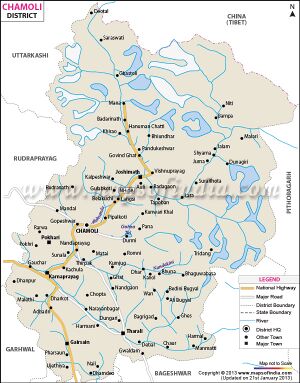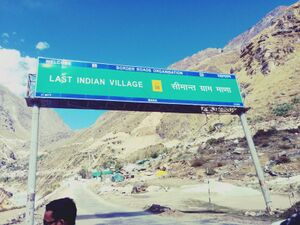Mana Chamoli
| Author:Laxman Burdak, IFS (R) |


Mana (माणा) is a village in the district of Chamoli in the Indian state of Uttarakhand.
Location
Mana is located at an altitude of 3,200 meters.[1] It is located on the northern terminus of National Highway-58, Mana is the last village before the Mana Pass and is 26 km from the border of India and Tibet. The village is at a distance of about 3 km from the Hindu Pilgrimage Badrinath and the two places are culturally connected with each other.[2]
Jat clans
History
Population
As per Census 2011 the village had about 558 households and a population of about 1214.[3] The people belong to Marchhas and Jads or Bhotias. During winter months, the entire populations comes down to lower places, as the area is covered under snow.[4]
Mana Pass
Mana Pass is located within the Nanda Devi Biosphere Reserve, 47 km north of the town of Mana, India and 52 km north of the Hindu pilgrimage town of Badrinath in Uttarakhand. It is the source of the Saraswati River, the longest stem of one of the longest Ganges tributaries, the Alaknanda River.[5] That river trickles through several scenic small ponds between the pass and Lake Deo Tal three km southwest of the pass. Mana pass is also the key col for climbing Chaukhamba peak.
Mana as a name derives from "Manibhadra Ashram", the ancient name of the town of Mana.[6]
History: Mana Pass was an ancient trade route between Uttarakhand and Tibet. Mana Pass led from Badrinath to the kingdom, now province, of Guge in Tibet. The Portuguese Jesuits António de Andrade and Manuel Marques became the first known Europeans to enter Tibet across Mana Pass in 1624. The pass continued as a minor trade route until its closure in 1951 by the Chinese. On April 29, 1954, China and India signed an agreement granting pilgrims and indigenous travelers the right to travel between the two countries through Mana Pass.
Access: The pass is reached from the south by an extension of India National Highway 7 (NH-7, old number NH-58) that connects Fazilka with Badrinath, though beyond Badrinath the graded road is subject to landslides.
Tourist places
- The villagers of this village are culturally associated with activities of Badrinath temple and annual fair of Matha murthi. They used to trade with Tibet in earlier days.
- There is a small cave in Mana, named Vyas Gufa and it is believed that Maharshi Vyas composed Mahabharatha in this cave.[7]
- One more cave is called Ganesh Gufa and tourists visit both caves regularly.
- Nearby places include Vasudhara Falls, Satopanth Lake, Bhim Pul, Saraswati Temple etc.
Notable persons
External links
References
- ↑ Bisht, Harshwanti (1994). Tourism in Garhwal Himalaya : with special reference to mountaineering and trekking in Uttarkashi and Chamoli Districts. New Delhi: Indus Pub. Co. pp. 90–92. ISBN 9788173870064.
- ↑ Bisht, Harshwanti (1994). Tourism in Garhwal Himalaya : with special reference to mountaineering and trekking in Uttarkashi and Chamoli Districts. New Delhi: Indus Pub. Co. pp. 90–92. ISBN 9788173870064.
- ↑ "Mana, Uttarakhand census 2011 data". Office of the Registrar General and Census Commissioner of India. R
- ↑ Bisht, Harshwanti (1994). Tourism in Garhwal Himalaya : with special reference to mountaineering and trekking in Uttarkashi and Chamoli Districts. New Delhi: Indus Pub. Co. pp. 90–92. ISBN 9788173870064.
- ↑ http://www.tourism-of-india.com/mana.html
- ↑ http://www.tourism-of-india.com/mana.html
- ↑ Bisht, Harshwanti (1994). Tourism in Garhwal Himalaya : with special reference to mountaineering and trekking in Uttarkashi and Chamoli Districts. New Delhi: Indus Pub. Co. pp. 90–92. ISBN 9788173870064.

